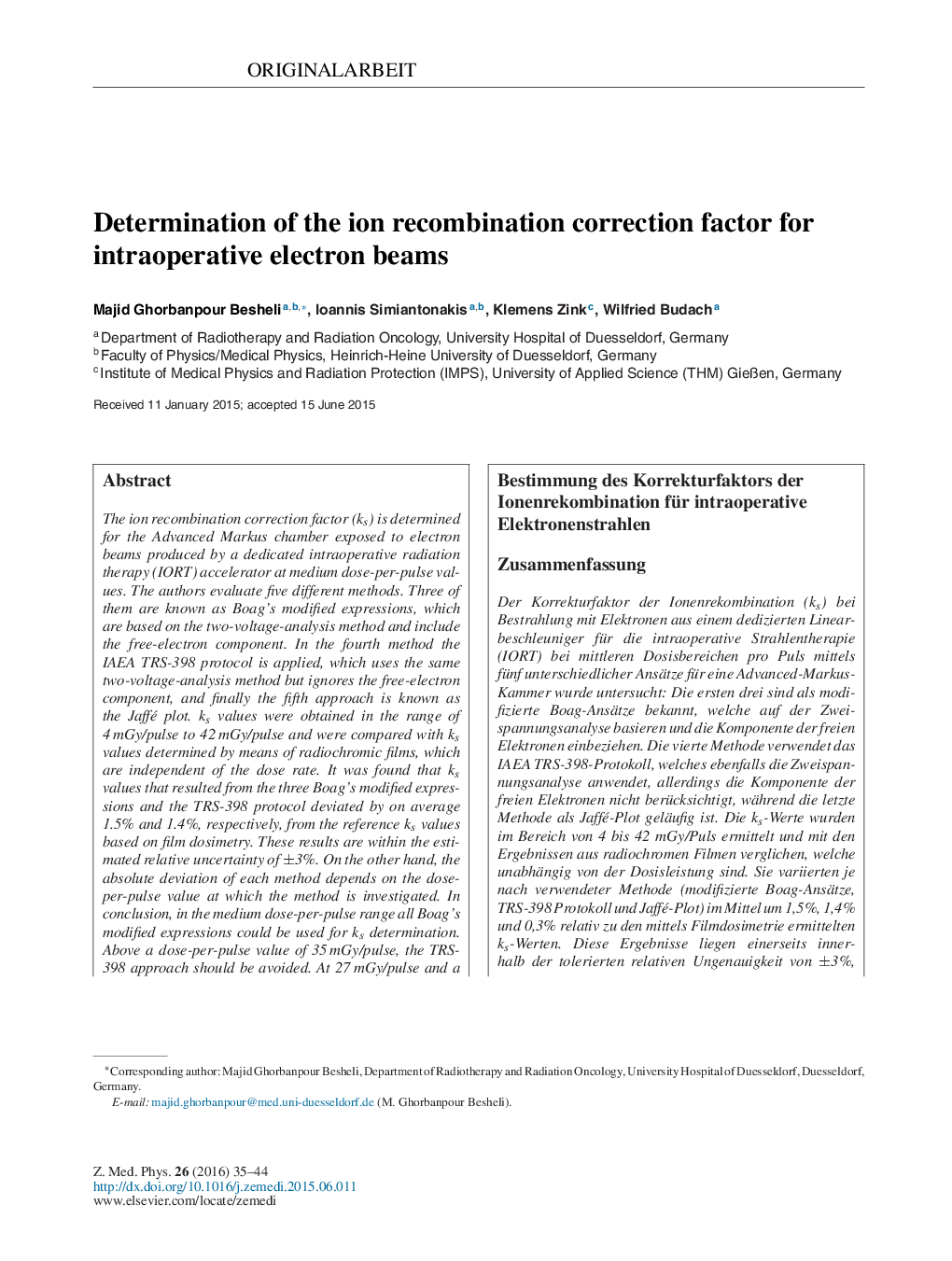| کد مقاله | کد نشریه | سال انتشار | مقاله انگلیسی | نسخه تمام متن |
|---|---|---|---|---|
| 1894897 | 1044253 | 2016 | 10 صفحه PDF | دانلود رایگان |
The ion recombination correction factor (ks) is determined for the Advanced Markus chamber exposed to electron beams produced by a dedicated intraoperative radiation therapy (IORT) accelerator at medium dose-per-pulse values. The authors evaluate five different methods. Three of them are known as Boag's modified expressions, which are based on the two-voltage-analysis method and include the free-electron component. In the fourth method the IAEA TRS-398 protocol is applied, which uses the same two-voltage-analysis method but ignores the free-electron component, and finally the fifth approach is known as the Jaffé plot. ks values were obtained in the range of 4 mGy/pulse to 42 mGy/pulse and were compared with ks values determined by means of radiochromic films, which are independent of the dose rate. It was found that ks values that resulted from the three Boag's modified expressions and the TRS-398 protocol deviated by on average 1.5% and 1.4%, respectively, from the reference ks values based on film dosimetry. These results are within the estimated relative uncertainty of ±3%. On the other hand, the absolute deviation of each method depends on the dose-per-pulse value at which the method is investigated. In conclusion, in the medium dose-per-pulse range all Boag's modified expressions could be used for ks determination. Above a dose-per-pulse value of 35 mGy/pulse, the TRS-398 approach should be avoided. At 27 mGy/pulse and a maximum operation voltage of 300 V the ks value resulting from the Jaffé plot showed a 0.3% deviation from the reference value. More investigation on the Jaffé plot is necessary at higher dose-per-pulse values.
ZusammenfassungDer Korrekturfaktor der Ionenrekombination (ks) bei Bestrahlung mit Elektronen aus einem dedizierten Linearbeschleuniger für die intraoperative Strahlentherapie (IORT) bei mittleren Dosisbereichen pro Puls mittels fünf unterschiedlicher Ansätze für eine Advanced-Markus-Kammer wurde untersucht: Die ersten drei sind als modifizierte Boag-Ansätze bekannt, welche auf der Zweispannungsanalyse basieren und die Komponente der freien Elektronen einbeziehen. Die vierte Methode verwendet das IAEA TRS-398-Protokoll, welches ebenfalls die Zweispannungsanalyse anwendet, allerdings die Komponente der freien Elektronen nicht berücksichtigt, während die letzte Methode als Jaffé-Plot geläufig ist. Die ks-Werte wurden im Bereich von 4 bis 42 mGy/Puls ermittelt und mit den Ergebnissen aus radiochromen Filmen verglichen, welche unabhängig von der Dosisleistung sind. Sie variierten je nach verwendeter Methode (modifizierte Boag-Ansätze, TRS-398 Protokoll und Jaffé-Plot) im Mittel um 1,5%, 1,4% und 0,3% relativ zu den mittels Filmdosimetrie ermittelten ks-Werten. Diese Ergebnisse liegen einerseits innerhalb der tolerierten relativen Ungenauigkeit von ±3%, andererseits ist die absolute Abweichung jeder Methode abhängig vom Wert der Dosis pro Puls für welchen sie jeweils untersucht wurde. Zusammenfassend ist festzuhalten, dass die Ansätze nach Boag allesamt für die ks-Bestimmung geeignet sind. Ab etwa 35 mGy/puls sollte die Berechnung nach dem TRS-398-Protokoll vermieden werden. Für 27 mGy/Puls und die Maximalspannung der Ionisationskammer von 300 V weist der Jaffé-Plot eine Abweichung des ks-Wertes von lediglich 0,3% gegenüber dem Referenzwert auf. Für höhere Dosis pro Puls-Werte sind weitere Untersuchungen erforderlich.
Journal: Zeitschrift für Medizinische Physik - Volume 26, Issue 1, March 2016, Pages 35–44
